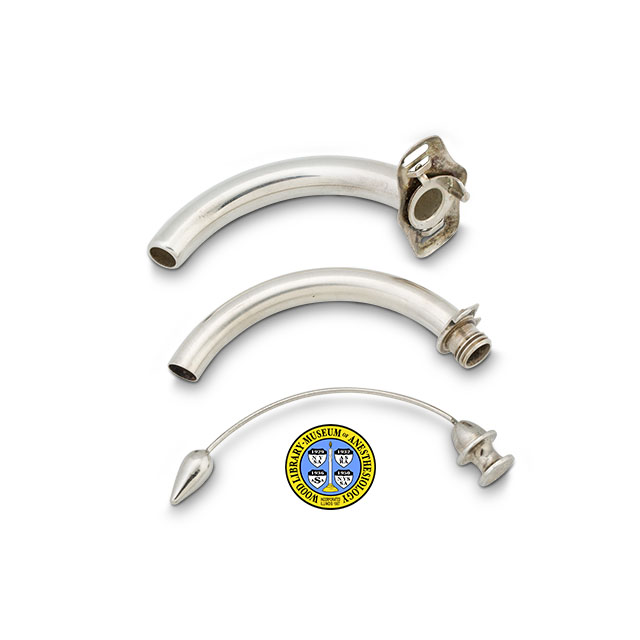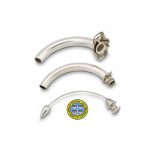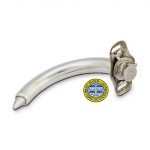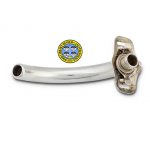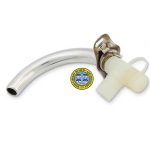Mörch Tracheotomy Tube
Anesthesiologists are responsible for maintaining the patient's respiration during surgery. Unlike an endotracheal tube, which is inserted through either the nose or mouth, a tracheotomy tube is inserted through an opening in the neck that is made by a surgical procedure. While tracheotomy is an ancient technique to bypass an obstructed airway, the insertion of breathing tubes through this opening dates from 19th Century.
Danish anesthesiologist Ernst Trier Morch, M.D. (1908-1996), developed several mechanical ventilators, including the Mueller-Morch Piston Respirator. Intended for use with a tracheotomy tube, it was made by V. Mueller & Co. in Chicago, and introduced in 1954. Two years later Dr. Morch introduced his own tracheotomy tube, a modification of the Jackson tube. This also was made by Mueller and marketed as an accessory to the Piston Respirator.
The patient's own movements, or those of an attached tube for the administration of air or anesthetic gases, could jostle a tracheostomy tube. An important feature of Morch's tube is a plastic swivel attachment. This minimized the transmission of motion to the tracheotomy tube, reducing discomfort to the patient and possible erosion of the trachea.
Catalog Record: Mörch Tracheotomy Tube 70. Morch Tracheotomy Tube
Access Key: aqss
Accession No.: 1996-04-06-1 L
Title: Morch tracheotomy tube / Designed by Ernst Trier Morch.
Author: Mørch, Ernst Trier (1908-1996).
Publisher: Chicago : V. Mueller & Co., [between 1956 and ca. 1980].
Physical Description: 1 tracheotomy tube : silver, plastics ; 4 x 5 x 12.5 cm.
Subject: Tracheotomy-instrumentation.
Subject: Anesthesia, Inhalation – instrumentation.
Note Type: General
Notes: Title taken from manufacturer’s product literature. The first year in the range of dates of possible manufacture is based on the date of introduction. The second year in the date range is based on contemporary, published descriptions. Described from the perspective of the patient.
Note Type: Citation
Notes: Encyclopedia of Chicago website. http://www.encyclopedia.chicagohistory.org/pages/806.html. Accessed June 12, 2018.
Note Type: Citation
Notes: Hung O, Murphy MF, eds. Management of the Difficult and Failed Airway, 2nd ed. New York: McGraw Hill Medical, 2012:319, 342-347.
Note Type: Citation
Notes: Meyer JA. Tracheotomy care. In: International Anesthesiology Clinics. Fall, 1966;4(3):675-686.
Note Type: Citation
Notes: Morch ET, Saxon GA, Gish G. Artificial respiration via the uncuffed tracheostomy tube. JAMA. March 10, 1956;160(10): 864-867.
Note Type: Citation
Notes: Morch ET, inventor. Piston type respirator. US patent 3,225,758, December 20, 1965.
Note Type: Citation
Notes: Morch ET, inventor. Tracheostomy tube construction. US patent 3,461,877. August 19, 1969.
Note Type: Citation
Notes: V. Mueller Company File. Archives. Located at: Wood Library-Museum of Anesthesiology, Schaumburg, Illinois.
Note Type: Citation
Notes: Mushin WW, Rendell-Baker L, Thompson PW, Mapelson WW. Historical background to automatic ventilation. In: Automatic Ventilation of the Lungs. Oxford: Blackwell, 1969:200-209.
Note Type: Citation
Notes: Rosenberg H, Axelrod HK. Ernst Trier Morch: inventor, medical pioneer, heroic freedom fighter. Anesth Analg. 2000;90(1):218-221.
Note Type: Physical Description
Notes: One tracheotomy tube; Consists of four pieces, an outer cannula, inner cannula, obturator and connector; The outer tube has a bracket on the distal end; When inserted, the inner cannula is held in place by a small lever that can be turned 180â° from left to right, catching on the rim of the bracket; The dimensions given in the short physical description are those with the inner cannula inserted, the connector attached and the connector’s cap hanging open; The dimensions with the inner cannula inserted, the connector attached and the connector’s cap closed are approximately 4 x 5 x 11 centimeters; The dimensions with obturator inserted are approximately 3.5 x 4 x 9 centimeters;
The threaded connector is made of translucent white plastic; The shape of the connector is that of a capital letter “T” with the vertical arm off-center; The vertical arm of the “T” is threaded so as to connect to a flexible breathing tube: The horizontal arm is threaded so as to connect to the inner cannula; The connector measures approximately 1.5 x 4 x 3.5 centimeters with the cap closed, and approximately 1.5 x 4.5 x 4.5 centimeters with the cap open.
The exterior side of the bracket is marked “V. Mueller” and “Sterling”; The interior side of the bracket is marked “7”, and what appears to be overlapping letters “I” and “N”; The flat end of the obturator is marked “7”.
Note Type: Reproduction
Notes: Photographed by Mr. Steve Donisch, January 16, 2018.
Note Type: Acquisition
Notes: Gift of Sys Trier Morch, daughter of the inventor.
Note Type: Historical
Notes: During surgery, anesthesiologists may use an endotracheal tube to administer air and anesthetic gases. An endotracheal tube is usually passed through the patient’s larynx (voice box) and into the trachea (windpipe); it is removed after the patient is breathing normally again. Tracheotomy is a surgical procedure to make an opening through the neck into the trachea. Operations of this kind have been performed for thousands of years. This may be done because of an obstruction in the patient’s airway, or to improve the delivery of oxygen.
The opening made by the procedure is called a tracheostomy. The insertion of a breathing tube through this opening dates from the late 19th century. Tubes for this purpose are called trachea, tracheostomy or tracheotomy tubes. They are equipped with an obturator (a plug) to keep the tube clear while it is being inserted. The obturator is withdrawn immediately after insertion, but it is kept handy in case the tube must be re-inserted. Tracheotomy can offer some advantages over endotracheal intubation for patients who require either long-term or permanent mechanical ventilation.
Both endotracheal and tracheotomy tubes may be equipped with an inflatable cuff that provides a tighter seal that enables more efficient intermittent positive pressure ventilation. One of the most enduring tracheotomy tube designs is that introduced in the early 1900s by Chevalier Jackson, M.D. (1865-1958), which remains available today. In the 1950s, it was studied by Danish anesthesiologist and inventor Ernst Trier Morch, M.D. (1908-1996) and his colleagues, who concluded that it was superior to cuffed tracheotomy tubes. This led to the design of Morch’s tracheotomy tube, which he called a modification of Jackson’s tube.
Dr. Morch was a strong advocate for the ventilation of patients during inhalation anesthesia, and developed several mechanical respirators. These included the Mueller-Morch Piston Respirator, made by V. Mueller & Co. in Chicago and introduced in 1954. The Morch tracheotomy tube was an accessory to this ventilator, although it was not patented until 1969.
Unlike the Jackson tube, Morch’s tube has a second, inner cannula. An important feature of the Morch tube is the T-shaped swivel connector, threaded at each of its three openings,
The inner end of the cross-piece of the “T” attaches to the inner canula, while the outer end holds a threaded cap; The cap is only opened to allow secretions in the tube to be suctioned out. The stem of the “T” can be connected to a hose for the administration of air or anesthetic gases. The manufacturer’s product literature states that the Morch tube “is so designed that the hose connection always rotates easily to eliminate torque, and the entire T-piece always swivels freely on its attachment to the neck of the inner cannula …. As it is impossible to tighten either of these connections completely, neither movements of the patient nor twisting of the hose from the respirator can be transmitted to the tracheostomy tube in situ, thus minimizing discomfort to the patient and possible erosion of the trachea”.
German immigrant Vincenz Mueller (1864-1942) founded V. Mueller & Co. in Chicago, Illinois in 1893. The company is noted for introducing standardized nomenclature and applying mass production techniques to medical instrument manufacturing. The company made both the Mueller-Morch Piston Respirator and the Morch tracheotomy tube. It also made the Ben Morgan ether apparatus, and the Herb-Mueller ether-suction apparatus. The V. Mueller brand was acquired by Becton, Dickinson and Company in 2014.
Note Type: Exhibition
Notes: Selected for the WLM website.
